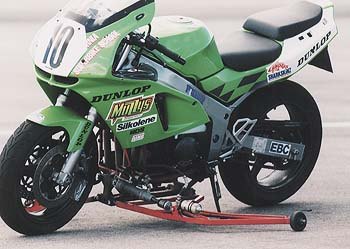Custom Bike: California Superbike School's Lean/Slide Bike - Motorcycle.com
If someone were to ask what is the most important thing about riding sport motorcycles, what would you answer? You'll probably say that it's going around corners. Your ability to negotiate turns will make all the difference on how fast and how smoothly you can ride a sportbike.
Even if you live in the flat American Midwest, you'll eventually have to learn how negotiate a corner or two.
A few years ago Keith Code placed outriggers on a motorcycle to allow students to experience -- without highsiding -- how it feels when the front brake of a motorcycle is locked. Later, he discovered that many students questioned a motorcycle's ability to lean. A new tool was needed, so Code created the Lean Bike.
Basically, the Lean Bike is a 1997 ZX-6R equipped with a set of outriggers that act like training wheels. The outriggers consist of a steel frame, hard rubber wheels and a pneumatically controlled lean damper system. To adjust the lean angle you push the horn button, which releases tension on the lean-damper. You can change the lean angle without releasing pressure, but it is difficult.
I rode the Lean/Slide Machine on a skid pad at the Streets of Willow Springs. First, an instructor hopped on the bike and repeatedly tried to highside. To date, no one has been able to flick it, but it is not immune to lowsides, so a bit of faith is involved. If you go too slowly, the bike can fall down. Also, while the bike itself is highside-proof, the rider is not. If you are not very careful, you can fly off the bike.
Right away I noticed that the bike doesn't steer: It feels like it has a sidecar on both sides. However, once the horn button is pushed the tension on the outriggers is released the bike may be leaned over. This is the biggest stumbling block for many students. Without the tension, they don't believe that the outriggers will help keep the bike upright and they are afraid to lean the bike. However, those who overcome their mistrust will make huge improvements.
I was at a slight lean when I pushed the button. Next, the bike slammed all the way over to full lean. Once there, if you trust it, you can experiment with body positioning. This will upset a normal bike, but not Lean Bike very much. After a few minutes of riding around in a big circle (and fighting dizziness), I was dragging knee.
Next the instructor popped off the seat and upped the rev-limiter. Now the Lean Bike was the Slide Bike. He challenged me to ride the bike and try to highside. The first time I tried I spent a lot of time getting over our inhibitions about throttle control, but eventually I just whacked it. Of course, I did what the Slide Bike is supposed to teach me not to do: Chop the throttle. I was sent sprawling onto the windshield but not flying through the air as would have been the case without the outriggers. After doing this a few times I asked the instructor how to slide the rear wheel.
The instructor explained that the trick is not to chop the throttle, which is a natural tendency, but to stay on the throttle and allow the bike catch up. He also explained that on a set of race-compound tires even Keith Code, at least at skid-pad speeds, had a hard time getting the rear to break loose. I was only on a set of sorry looking Dunlop 204s but they still stuck better than I thought they would.
Eventually I produced a few controlled slides. This is not to say that learning how to control a rear-wheel slide easy, but the Slide Bike is a good tool on which to learn. There are other ways to learn how to slide the rear wheel. For instance, flat track racing is an excellent way. Of course, there is also the good old-fashioned way: Trial and error on the street. However, flat track racing is very expensive and trial and error can be just as expensive (repair bills) and even more painful (medical bills). The Slide Bike is by far much less expensive and painful. If you're like me, and you prefer to keep money in the bank and your body in one piece, I recommend the Slide Bike.
The Lean Bike is available to students at California Superbike School in any level. The Slide Bike is for Level Three students and above.
More by Billy Bartels


































Comments
Join the conversation